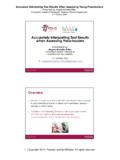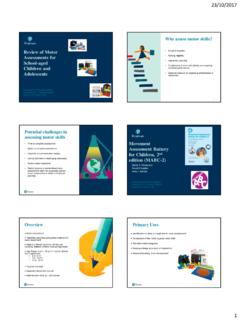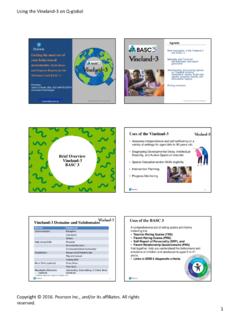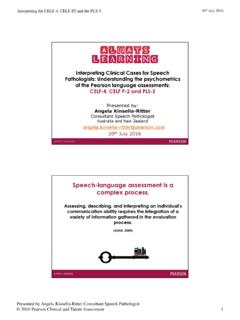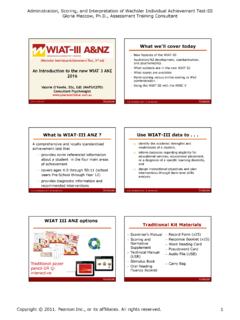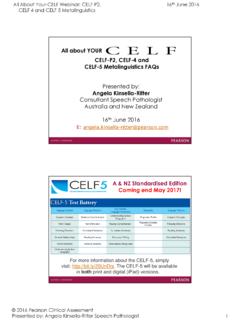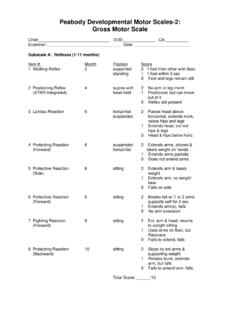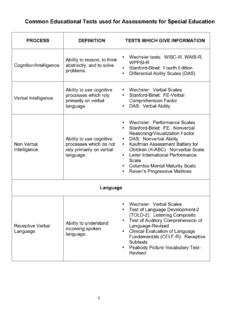Transcription of Motor Assessments for School Aged Children and Adolescents
1 23/10/2017. Why assess Motor skills? Establish baseline Review of Motor Funding eligibility Assessments for Intervention planning School -aged To determine if Motor skill deficits are impacting Children and functional performance Outcome measure for assessing effectiveness of Adolescents intervention Presented by Amy Schulenburg Consultant OT - Pearson Clinical Assessment (Aust & NZ). Potential challenges in assessing Motor skills Time to complete assessment Movement Space to complete assessment Assessment Battery Cognitive or communication delays for Children , 2nd Limited attention or challenging behaviours edition (MABC-2).
2 Severe Motor impairment Sheila E Henderson Performance on a standardised Motor David A Sugden assessment might not accurately capture Anna L Barnett Motor competence or deficit in functional activities Presented by Amy Schulenburg Consultant OT - Pearson Clinical Assessment (Aust & NZ). Overview Primary Uses Motor assessment Identification of delay or impairment in Motor development Identifies, describes and guides treatment of Comparison of fine Motor vs gross Motor skills Motor impairment . Plan intervention programs Subtests: Manual Dexterity, Aiming and Catching, Balance (8 items total per age band).
3 Measure change as a result of intervention Age Range: 3 yrs 16 yrs 11 months divided into 3 age bands: Research involving Motor development 3:0 6:11. 7:0 10:11. 11:0 16:11. Teacher Checklist Separate intervention manual Administration time 20 30 minutes 1. 23/10/2017. Layout of manual Age Band 1 tasks Posting Coins Threading Beads Each hand is tested 6 beads for 3-4 yr olds 6 coins for 3-4 yr olds 12 beads for 5-6 yr olds 12 coins for 5-6 yr olds Maximum of 2 trials Maximum of 2 trials Drawing Trail Age Band 1 Catching Beanbag (10 attempts).
4 2. 23/10/2017. Throwing Beanbag onto Mat (10 attempts). One-Leg Balance Each leg is tested Maximum time 30 seconds Maximum of 2 trials per leg Walking Heels Raised Jumping on Mats line Maximum of 2 trials Maximum score = 15 steps or when child reaches end of line Set up and start position Age Band 2 tasks Placing Pegs Each hand is tested Dominant hand first Start timing when free hand leaves mat Pegs can be inserted in any order Maximum of 2 trials per hand 3. 23/10/2017. Threading Lace Drawing Trail Age Band 2. Start position Catching with Two Hands Throwing Beanbag onto Mat Ten attempts A hit is counted when any part of the beanbag touches the circle A throw that bounces or slides onto circle after landing does not count Action ages 7-8 Action ages 9-10.
5 One-Board Balance Walking Heel-to-Toe Forwards Each leg is tested line Maximum score is 30 seconds Heel of front foot must touch toes of rear foot Board must not tilt such that a side touches the floor Maximum = 15 steps or when child reaches end of line Child must wear trainers Maximum of 2 trials 4. 23/10/2017. Hopping on Mats Age Band 3 tasks Child starts by standing on one foot 5 continuous hops Must finish in a controlled manner Each leg is tested Maximum of 2 trials per leg Turning Pegs Triangle with Nuts and Bolts Set up and Each hand is tested start position Start timing when free hand leaves mat Pegs can be placed in any order Maximum of 2 trials per hand Drawing Trail Age Band 3 Catching with One Hand Each hand is tested Child stands behind line 2m from wall No bounces allowed Ten attempts with each hand 5.
6 23/10/2017. Throwing at Wall Target Two-Board Balance Narrow part of board facing up Child stands behind line from wall Maximum time is 30 seconds Lower edge of target level with top of child's head Sides of feet should not touch base of boards Ten attempts Maximum of 2 trials Child must wear trainers Walking Toe-to-Heel Backwards Zig-Zag Hopping Each leg is tested line Child hops once on each mat Toe of rear foot must touch heel of front foot No pausing between hops Maximum score = 15 steps or when child reaches end of line Must finish in a
7 Controlled manner Maximum of 2 trials per leg Example of Item Scoring Scoring Colour coded record forms Age Band 1 = red Age Band 2 = green Age Band 3 = blue Scores available Item standard scores (mean 10, SD 3). Component standard scores and percentiles Total assessment standard score (mean 10, SD 3). and percentiles 6. 23/10/2017. Scoring Scoring Appendix B pages167-176 of manual Percentile cut-offs: <5th percentile = significant Motor difficulty 6 15th percentile = careful monitoring suggested >15th percentile = no significant Motor difficulty Can record qualitative observations and factors that may have affected performance Compare non- Motor factors between School and therapist observations Teacher Checklist Section A Static/Predictable environments Self care skills Classroom skills PE / recreational skills Section B Dynamic/Unpredictable environment Self care / Classroom skills Ball skills PE / recreational skills Section C.
8 Non- Motor factors that influence movement impulsivity, distractibility, persistence, anxiety Checklist Scoring Norms for 5-12 year olds Calculate totals for each section: If >3 items marked Not Observed' you cannot obtain total score Total Motor Score = Section A + Section B. Total Motor Cut scores: Red Zone definite movement difficulties Amber Zone at risk' or needs further investigation Green Zone no apparent movement difficulties 7. 23/10/2017. Ecological Intervention Handbook Reliability and Validity Takes into account studies from Movement ABC-1.
9 And studies with Movement ABC-2 (items with the lowest reliability were removed). Test-retest reliability (total test score ). Content validity established via expert panel Discriminative validity study showed differentiation of Children with DCD and Asperger's Syndrome Correlation studies for criterion-related validity with M- ABC considered to be relevant to M-ABC2: Bruininks-Oseretsky Test of Motor proficiency (1978). peabody developmental Motor Scales second edition (2000). Beery Test of Visual Motor Integration (1967). Advantages Examples of clinical use Different tasks depending on age Screening purposes (is there a clinically No standardised verbal instructions (bullet-point significant problem?))
10 Guidelines). Short admin time Children with receptive language issues Teacher checklist to take into account performance in Children with limited cognitive ability typical environment Children with poor attention Observations check boxes to guide clinical observations Children who are guaranteed to fail but need a Separate Intervention manual standardised score for funding Contrasting colours to assist Children with visual When time is limited impairment Research Floor mats for reduced set up time (still some use of tape). Potential drawbacks Only 8 items per age band Bruininks-Oseretsky Missing common tasks cutting Component skill focused Test of Motor UK norms Proficiency - 2.

